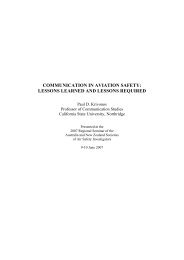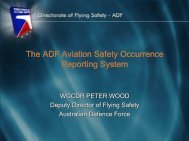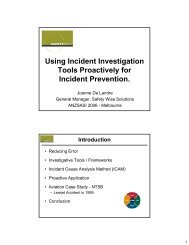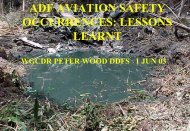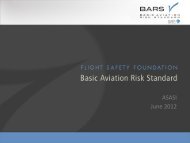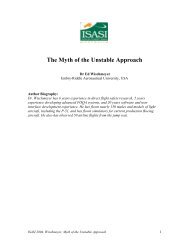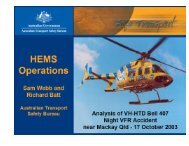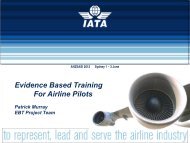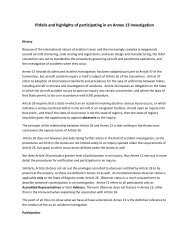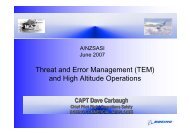Using Incident Investigation Tools Proactively for Incident ... - ASASI
Using Incident Investigation Tools Proactively for Incident ... - ASASI
Using Incident Investigation Tools Proactively for Incident ... - ASASI
You also want an ePaper? Increase the reach of your titles
YUMPU automatically turns print PDFs into web optimized ePapers that Google loves.
_____________________________________________________________________<br />
Modern investigation methodologies not only identify how an incident occurred, but also<br />
identify why it occurred. Most importantly, corrective actions and key learnings arise from<br />
the investigation aimed at preventing similar incidents from occurring again. However, the<br />
effectiveness of corrective actions and key learnings in reducing error is clearly an area which<br />
needs to be improved upon, evidenced by repeat incidents seen through-out many industries.<br />
IMPROVING SAFETY AT AN ORGANISATIONAL LEVEL<br />
Standard investigation methodologies examine the physical evidence at an incident site, the<br />
defences that failed to prevent or mitigate the incident, the actions of people involved, the<br />
conditions that existed and the pertinent organisational factors. While this is usually effective<br />
at determining why a particular accident occurred, the investigation methodology is not<br />
focused on, and there<strong>for</strong>e is not very effective at, making organisations safer.<br />
In order to improve safety at an organisational level and identify and reduce the precursors to<br />
error, a more holistic tool is required which examines the full range of organisational<br />
elements from a proactive stance. While a number of tools can be used <strong>for</strong> this purpose, this<br />
paper will focus on the <strong>Incident</strong> Cause Analysis Method.<br />
INCIDENT CAUSE ANALYSIS METHOD (ICAM)<br />
The principles of the <strong>Incident</strong> Cause Analysis Method (ICAM), stem from the work of<br />
organisational psychologist and human error expert, Professor James Reason and his<br />
modelling of organisational accidents. Reason and his colleagues from the University of<br />
Manchester in the United Kingdom, developed a conceptual and theoretical approach to the<br />
safety of large, complex, socio-technical systems, of which aviation and mining are excellent<br />
examples.<br />
Reason defines organisational accidents as those in which latent conditions (arising mainly<br />
from management decisions, practices or cultural influences), combine adversely with local<br />
triggering conditions (weather, location etc.) and with active failures (errors and/or procedural<br />
violations) committed by individuals or teams at the front line or "sharp end" of an<br />
organisation, to produce an accident (Reason, 1990; 1997).<br />
A fundamental concept of ICAM is acceptance of the inevitability of human error. Human<br />
factors research and operational experience, has shown that human error is a normal<br />
characteristic of human behaviour, and although it can be reduced, it cannot be completely<br />
eliminated (Helmreich & Merritt, 2000). ICAM is designed to ensure that the investigation is<br />
not restricted to the errors and violations of operational personnel. It identifies the local<br />
factors that contributed to the incident and the latent hazards within the system and the<br />
organisation (Gibb & De Landre, 2002). Through the analysis of this in<strong>for</strong>mation, ICAM<br />
provides the ability to identify what really went wrong and to make recommendations on what<br />
needs to be done to prevent recurrence. It is directed towards building error-tolerant defences<br />
against future incidents.<br />
SPECIFIC OBJECTIVES OF ICAM<br />
The specific objectives of investigations using ICAM are:<br />
1. To establish all the relevant and material facts surrounding the event.<br />
2. To ensure the investigation is not restricted to the errors and violations of operational<br />
personnel.<br />
___________________________________________________________________________________<br />
~ ANZSASI 2006 : De Landre, Gibb and Walters ~<br />
Page 2 of 12



